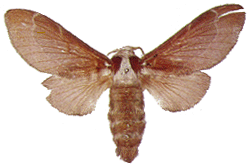|
Streblote helpsi
sp.
n.
|

Streblote helpsi ♂
(paratype)
(natural
size)

Streblote helpsi ♀
(paratype)
(natural
size)
|

|
♂♂21-23mm,
♀♀
32-36mm.
The males are dark brown as in the Philippines species castanea Swinhoe, but
larger, with the hindwing distal margin straight to convex rather than slightly
concave. There is a fine white postmedial that is further from the margin than
that of castanea, entire rather than fading away centrally, and bilobed rather
than monolobed subapically. There is a faint antemedial posterior to the cell,
and a pale dash at the centre of the costa. The genitalia are as in castanea,
but differ from those of the more contrasty, white banded enthismena Tams from
Singapore in that the longer arm of the valve is more outcurved, and the cubile
arms have the darker, serrate part more slender, with a more regular interior
margin.
The females vary
from the specimen illustrated in lacking pale fasciae on the wings or having them
more pronounced. In castanea they are almost always pronounced, and there is a
broad, diffuse, creamy white hand to the hindwing.
Holotype ♂.
BRUNEI: 0m, S. Selanjak, 4464/1432), mangrove 8-9. iii. 1984 (Maj. T.P.G.
Helps).
Paratypes: 1♂(slide
997), 2♀♀
BRUNEI, [reared from Casuarina ex. Dept. Agriculture] (D.J. McCrae); 1♀
BRUNEI: 3m, Seria, secondary and coastal veg., 10.2.1980 (Lt. Col. M.G. Allen)
bred from Casuarina; 1♀
BRUNEI: 3m, Mumong, secondary and coastal veg., 28.11.1979 (R. Fairclough).
Geographical
range. Borneo.
Habitat preference. The
few specimens have been taken mainly in coastal habitat in Brunei.
Biology. The
species has been reared from Casuarina equisetifolia in Brunei, one of the major
components of coastal strand forest.
<<Back
>>Forward <<Return
to Contents page
|

